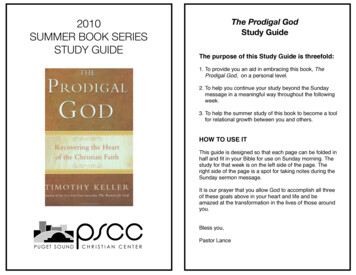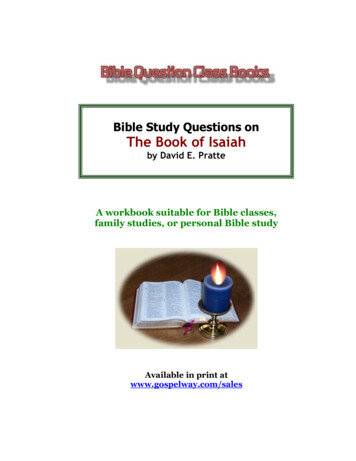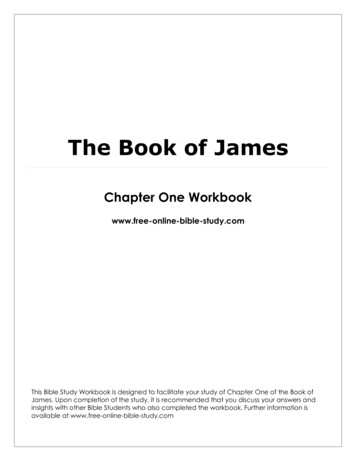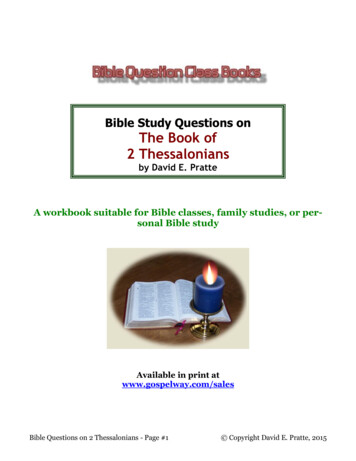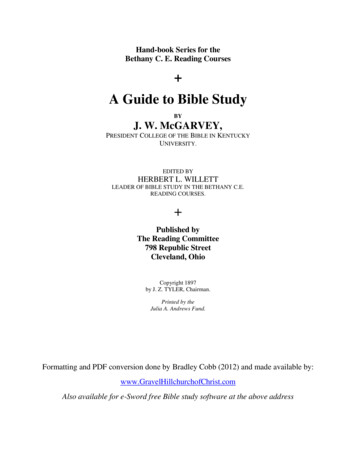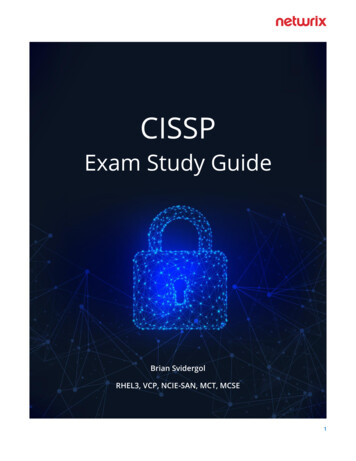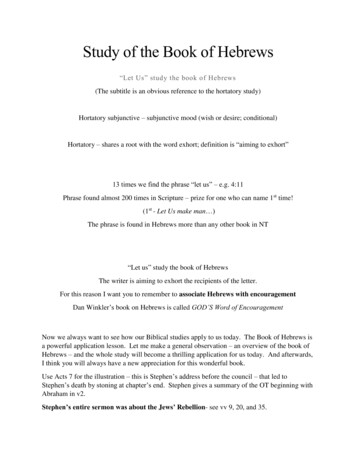
Transcription
Study of the Book of Hebrews“Let Us” study the book of Hebrews(The subtitle is an obvious reference to the hortatory study)Hortatory subjunctive – subjunctive mood (wish or desire; conditional)Hortatory – shares a root with the word exhort; definition is “aiming to exhort”13 times we find the phrase “let us” – e.g. 4:11Phrase found almost 200 times in Scripture – prize for one who can name 1st time!(1st - Let Us make man )The phrase is found in Hebrews more than any other book in NT“Let us” study the book of HebrewsThe writer is aiming to exhort the recipients of the letter.For this reason I want you to remember to associate Hebrews with encouragementDan Winkler’s book on Hebrews is called GOD’S Word of EncouragementNow we always want to see how our Biblical studies apply to us today. The Book of Hebrews isa powerful application lesson. Let me make a general observation – an overview of the book ofHebrews – and the whole study will become a thrilling application for us today. And afterwards,I think you will always have a new appreciation for this wonderful book.Use Acts 7 for the illustration – this is Stephen’s address before the council – that led toStephen’s death by stoning at chapter’s end. Stephen gives a summary of the OT beginning withAbraham in v2.Stephen’s entire sermon was about the Jews’ Rebellion- see vv 9, 20, and 35.
Beginning in v37 he recounts how when Moses led the children out of captivity – they becamerestless, rejected him (Moses) and even wanted to go back to Egypt!Note v39 – “in their hearts” – this is where the problem begins.Now those in Stephen’s time hearing his speech had the same response, that is, they rejected theHoly Spirit. See v51 – they were just like their fathers. They rejected Jesus and crucified Him –now they rejected Stephen and killed him – they chose to go back to the Old Law – see 6:14.Note the groups of GOD’S children that had rejected truth in the OT –1. Children in wilderness rejected Moses2. Consider the up and down cycle of all the judges or the Promised Land and all the idols3. The Assyrian and Babylonian captivity4. The Jews had rejected Christ5. The council rejected Stephen and stoned himNow if you consider this scenario you have the jest of the book of Hebrews. Book likely writtenduring a time of persecution (probably Nero in 60’s?). Jewish Christians, thinking they hadgiven up everything to follow Christ, were considering renouncing their faith and going back toLaw of Moses, to the bondage of the Old Law.Book of Hebrews has the same message that Stephen preached – see Heb 3:3, 7-8; 10:29So the application to us is obvious – whatever we came out of when we were converted (all ofus, a sinful life, some maybe denominational error, etc.) – no matter what happens to us in lifewe MUST maintain our faith – DO NOT consider going back! (Essentially the message ofchapter 10)I have visited recently with someone who was once a faithful Christian who has now turned theirback on the truth. (This one is actually a practicing Jehovah’s Witness now)The message of Hebrews is loud and clear – DO NOT GO BACK.As we always do we will spend a good amount of time (likely a few weeks) on the overview ofthe Book before we get into the textual study.
With each chapter our plan will be to approach it from 2 ways1. A general textual study – not too detailed, maybe not even verse by verse, more marginalnotes, Wayne Jackson’s commentary will help with this approach – it is a rich studyindeed!2. The lessons for us – these are found in Frank Dunn book, the Bible Bullets project, DanWinkler’s study of Hebrews, Wayne Jackson, Prophet Priest and King bookThe 3 Profound Studies– this alone will be most of one class – ButI want to emphasize the 3 Books together – starting with the 2 previously studied and then seehow Hebrews completes the study. With all the texts emphasize their obvious tie with Hebrews.(Put the bold remarks and maybe the verses but then gray the verses out on the succeeding slideon Power Point – visit the passages with the class) Romans – proves the necessity of the Gospel – see the book of Romans in 8 passages1:16-17; 3:21-23; 5:8-10; 6:3-4; 6:17; 8:1; 10:17; 12:2A review of the fact we are saved by the Gospel!!Gospel is the power – dunamis – interesting word to the power hungry RomansBefore we go to Revelation – Rom 8:18 sums up the book of Revelation Revelation – shows the ultimate triumph – see v 2:10cSee Rev 12:11 - Theme of the Revelation is “overcame” (Nikao) – note the 3 points howthey overcame And they overcame him ᶦby the blood of the Lamb and ²by the word of their testimony,and ³they did not love their lives to the death.
Rev 17:14These will make war with the Lamb, and the Lamb will overcome (nikao)them, for He is Lord of lords and King of kings; and those who are with Him are called,chosen, and faithful.The outcome has already been decided!! The ultimate triumph!!Hebrews – proves the superiority of Christ over angels, Moses, the prophets – see8:1(a)We’re going to simply note these verses now more about them later Hebrews 4:14 – The Key Verse – more about this later The Gospel in one verse – Heb 9:26 but now, once at the end of the ages, He has appeared to put away sin by the sacrificeof Himself.Recall the theme of the Bible - The salvation of man – through Christ – to the glory ofGOD – as revealed by the Spirit.Outline of the Book – does remind me somewhat of Romans – 1st part doctrinal, rity of Christ over Angels1:4 – 2:18Superiority of Christ over Moses3:1 – 4:13Superiority of Christ over the OT High Priest4:14 – 10:18Practical Applications10:19 – 13:17Conclusion13:18-25
I’d like to take a few minutes and take a side trip in our study – I think you will find thisinteresting. Let’s briefly look at the derivation of the word Hebrews .there is actually a coupleof thoughts. Let’s go back to the genealogy of Noah’s 3 sons.B S Dean’s 15 Periods of Bible History (1912) is a profitable study1st Period – Antediluvian (Before the flood) – only 6 chapters in Genesis – date 4000-2348 BC2nd Period – Post Diluvian – sometimes referred to as “the 2nd Beginning”Let’s ReviewWe’ll spend another week or 2 on some introductory matters before getting into the text.If you are not currently in a reading plan, let me suggest this the book of Hebrews has 13chapters, read 2 chapters a day and 1 on Sunday, reading through the book each week; do thatwhile we study this great book and when we finish you will have read the book close to 40times you will know this great book!A quick review of week 1 1. “Let us” – found 13 times - remember the message of Hebrews is one of‘encouragement’Example – not a ‘you do thus and so’ but rather ‘let’s, you and me, do thus and so ’2. Message of Hebrews is loud and clear – DO NOT GO BACK!Throughout history GOD’S people have rebelled or turned backThis is a powerful message for us today – if we are faithful Christians, don’t go back!3. Romans – Revelation – Hebrews not only 3 most profound books – they fit togetherRom necessity of gospel; Rev the triumph in the end; Heb superiority of Christ andexhortation to stay the course!Hebrews is my favorite of the 3 – but I said the same about the other 2!4. When class ended last, we has just asked, “Where does the word ‘Hebrew’ come from?”
Gen 10 gives us a genealogy of the sons of Noah: Shem, Ham, and Japheth and the sons born tothem after the flood. And though it is an interesting study, we have looked at this in detail beforeso we’ll be very brief today.Japheth – 10:2ff – Javan – Ancient name for the Greeks – Gentiles (v5), the EuropeansHam – 10:6ff – Cush is ancient name for Ethiopia; Mizraim is ancient name for Egypt; Phut isname for Libya the AfricansNote the Assyrians in v11 – role they will play later in OT; Philistines in v14Others in this bloodline – Nineveh (v11); Sodom and Gomorrah (v19)Shem – 10:21ff – something special About Shem; He is the Messianic leg His descendants were those of Middle Eastern descentNote Shem’s 2 descriptions1. Note he is listed 1st when normally this is elder 2. Also note “the father of all the children of Eber”Eber is his great grandson – so why would Shem be identified as such, why wouldEber be pointed out in particular?Most scholars say Eber is where the name Hebrew comes from11:10-26 gives the 10 generations from Shem to AbSee 14:13 for 1st use of HebrewHebrews (the word “Semitic” as in Semitic language comes from word Shem)Why we use the phrase today – “anti-Semitic” – for those prejudiced against the Jews
Hebrew according to Dictionary.com – “the Semitic (!) People inhabiting ancientPalestine”Asians – Christ came through this rootGenesis 11:10 – 26 reveals Ab came through family of Shem.There is another school of thought with respect to the derivation of the word HebrewThe Septuagint has perates for Hebrew in 14:13 – perates means one who passes over. This mayhave been given Abraham by the Canaanites because he came from the region beyond theEuphrates.Either way this much we knowIn the OT the word Hebrew along with name Israelite refers to descendants of Jacob. Gen 32Jacob’s name is changed to Israel.Not so in the NT – in NT name Hebrew seems to have something to do with language – Acts 6:1;2 Cor 11:22; Phil 3:5Webster defines word Hebrew – as the ancient Semitic languageIf this is true then the letter – To the Hebrews – was addressed to the Jewish Christians inPalestine – they were the only Christians at that time who spoke the Hebrew language (Aramaic)The internal evidence of the book harmonizes best with the supposition that it was addressed tothe Jewish Christians in Palestine.Now let’s return to our study of Hebrews for some keys to the study 1. Who wrote the book? There are at least 8 different theories. Do not speculate on this.The Bible does not tell us so we will refer to it simply as the writer of the book ofHebrews! But of all the possibilities I will say this – after this study there is a one whointrigues me now – as we have noted earlier – the book is a message of encouragement –who do you think of as the encourager? Barnabas (as a companion of Paul – he is
mentioned as a possible penman). Tertullian, circa 200, quoted from “an epistle to theHebrews under the name of Barnabas”.Make comment about where it is located in the canon of Scripture – Pauline writings, 1stto churches by length, then to the individuals; then we have the General Epistles, thelargest of which is Hebrews – then James, Peter, John, Jude; lastly the book of prophecy.2. To whom was it written? Now this is another story in that we can answer this question.A casual reading of the book will reveal:To Jews who had been converted to Christianity and were in danger of apostasy by returning toJudaism.Why do we say this? At least 4 very solid reasons a) By the book’s use of OT scriptures. Every chapter quotes from the OT. All total nearly100 references to OTb) OT history is referenced repeatedly, i.e. 2 chapters devoted to the wilderness wanderings,ch 3-4; 4 chapters discuss the Levitical priesthood, ch 7-10; giving of the old law in ch12;c) The OT heroes in ch 11 as well as Ab, Melchizedek and Moses throughout the bookd) The recipients knew Timothy (“our brother”) – 13:233. When was it written? Circa 65 AD - Before AD 70 because temple was still standing –5:1; 9:25; 10:1, 3, 11; 13:10, 11.Remember Peter and Paul’s death, while impossible to definitively date, most scholarsplace the death of both in the mid-60’s at the hand of Nero. Nero listed by Foxe as the 1stgreat persecution from Roman Emperor. Maybe this persecution was the force drivingsome Christians to question their faith and return to Judaism leading to the why.Maybe the most compelling verse for a pre-AD 70 date is 12:27.
4. Why was it written? This question is easy to answer as well .We’ll let the text answer the question – by visiting 5 passages and culminating with a 6thSo why was it written?2:1some were in danger of drifting – back to Judaism3:12evil heart of unbelief leading them to depart and become hardened thru deceitfulness 5:11since you have become dull of hearing – some versions say “you are dull of hearing”10:26 returning to a lifestyle of sin – present tense as opposed to a single act12:12 they were discouragedLeading to 13:22the entire letter is a word of encouragement – hold fast, draw near, betterIt is a book of encouragement – Dan Winkler’s book entitled “GOD’S Word of Encouragement”Neil R. Lightfoot in his book Jesus Christ Today – “Hebrews is the greatest piece ofexhortation found in the New Testament.”Reminder of the subtitle “Let Us study Hebrews” – the hortatory expression!Why was it written? Very simply and very important for us Christianity is superior to Judaism AND all other religions. The lessons encouraging us toremain committed to the truth are very much needed today regardless of what we are facing.DO NOT GO BACK!The purpose of the book was to prevent apostasy!5. Key Word(s) – Better, Great; therefore (appears 28 times); heart (11 times) leading usto6. Key Phrase – Do not harden your hearts – 3:7. 15; 4:77. Key Verse – 7:22
Hebrews is Christ centered – Christ is found in every chapter!Key word is better!Jesus is the guarantor, guarantee, or pledge of this better covenantThe message of the book – This new covenant is ‘so much better’ than the oldLet’s ReviewFor many years I didn’t do an organized reading plan because I thought studying the Bible dailywas a reading plan. I now do both and encourage you to do the same Study – 2 Tim 2:15; the Bereans in Acts 17:11 searched the Scriptures dailyRead – Rev 1:3; Eph 3:4, Paul says mystery, revelation, write, you read, you understandAnnounce again the suggestion for reading through the book of Hebrews weekly as we study.Can be accomplished by reading 2 chapters a day M-Sat and 1 on Sunday. Even if you are in areading plan, try to read through the book a few times during our study. Allen Highers said thatbefore he taught or put together a study of a particular book, he would sit down and read itthrough. Preferably in one sitting, remember it is a letter written to recipients.Only going to go back in review and recall the Keys to the Book Key words – Better, great, therefore, heartKey Phrase – Do not harden your hearts; “Let us”Purpose of the book – to prevent apostasy – Do Not Go Back – recall the Christian I metrecently who had gone into apostasy – with the Jehovah’s WitnessesKey Passage – 7:22 - by so much more Jesus has become a surety of a better covenant.Christ is found in every chapter.There are a couple of other key verses, but before we look at them, I want to observe
The Layout of the BookWe have grouped Hebrews with Romans and Revelation previously to draw some similarities.Hebrews is similar to Romans in that the 1st part is doctrinal (thru 10:18), 2nd application(10:19ff).Romans – chps 1-11 doctrinal; 12-16 applicationBoth books are books of logical conclusions – Therefore – Rom 34 times, Heb 28 timesThe book of Hebrews also shares a unique feature with the Revelation letter. Recall inRevelation, we’d be going along with a topic and then take an interlude – e.g. the 7 Seals, #1-6were discussed then an entire chapter is inserted as an interlude, a kind of timeout, before doingSeal #7. Same thing with the 7 Trumpets.Here in Hebrews – we have 5 Sections each consisting of Doctrine then sort of interlude – aWarning or EncouragementNote each of the warnings begin with “therefore”Also note in each warning or exhortation section, we will highlight one verse. If you noteeach of these verses then when we finish you will have 5 Great Exhortations from Hebrews.Prepare handout for the class – Go over this together – worthy section, don’t hurry through itLayout of the book of HebrewsIntroduction1: 1-2aSection 11:2b – 14DoctrineThe Supremacy of Christ over angels2: 1-4WarningDon’t drift away from His word (emph v1)2: 5 – 3:6DoctrineChrist is the captain of our salvation3:7 – 4:13WarningDon’t harden your hearts to His voice (emph v8)Section 2(Note it appears 3 times – vv 8, 15, 4:7)
Section 3Section 4Section 54:14 – 5:11DoctrineChrist is our High Priest5:12 – 6:20WarningDon’t fall away from Him (emph v6)7:1 – 10:18DoctrineChrist is the Mediator of a better covenant10:19 – 39WarningDon’t cast away the Only Way (emph v35)11:1 – 40DoctrineExamples of an active obedient faith in Christ12:1 – 29WarningDon’t refuse Jesus who speaks (emph v25)Chapter 13Final Appeal and ConclusionNow if you marked the verses of emphasis you have 5 great verses of exhortation!Also note, Hebrews is Christ centered – HE is found in every chapter, section, and warning.More Key Verses: Hebrews 4:14This is also a key verse but I didn’t want to note it until we talked about the layout –-Christ is our High PriestDoctrine“Let us” hold fast our confessionWarning or ExhortationThis is the summation of the entire bookDoctrine and Warning or ExhortationSeveral Other Notable Texts: Maybe just reference and read these now, study later Hebrews 3:12 – 13This is the purpose of the book – To prevent apostasy
Hebrews 10:19 – 25Just note the passage; wait until we have the textual study to get into thisNote – 3 “let us” statements – Faith, Hope, and Love Hebrews 11:6Faith is necessaryMust believe 2 things – note them Hebrews 12:1-2Therefore – on the heels of ch 1112:1 we find 2 of our 13 “let us” passagesMore during our textual studyHighlights of each chapter – Christ in each chapterDo this like we did the Revelation study – use this as an overview of the Book. Refer to a verseor two in passing.1. The supremacy of Christ - Jesus, being the Son of God, is a greater Messenger than theprophets and angels – v4a2. Christ the captain of our salvation, the great salvation - Warning against neglecting thissalvation and Jesus is the Founder of that salvation – v33. Christ the Apostle and High Priest of our profession - Jesus is greater than Moses; v3aJesus provides rest for the people of God if they do not harden their hearts, as Israel didin Moses’ day – v13b;4. Christ our comfort and example - Jesus provides a greater rest than Joshua did; v8Jesus is the great High Priest – v14a
5. Christ a High Priest after the order of Melchizedek; v10The danger of remaining babes in Christ – v126. Christ is our forerunner. Warning against apostasy; God’s promise to Christians iscertain, just as His promise to Ab was certain – v207. Christ is our High Priest. The priestly order of Melchizedek is contrasted with theLevitical priesthood - Jesus compared to Melchizedek – v268. Christ the mediator of a new and better covenant – Jesus is the High Priest of a bettercovenant, enacted on better promises; The old covenant is obsolete – v1, 13a9. Christ’s new testament of force after His death; His sacrifice of Himself for the sins ofmankind –Worship by sacrifices in the tabernacle has been replaced by the blood of Christ, Whodied once for all – v28a10. Christ’s sacrifice is foreshadowed under the Law of Moses; The old law is done away –The blood of bulls and goats could not take away sins; Urging not to reject the sacrificeof Christ, which is the exclusive means of salvation – v19-20a11. There are only 2 choices - The reproach of Christ versus the treasures of earth – v 26.Chapter 11 is synonymous with the heroes of faith; definition and necessity of faith –Great Old Testament examples of obedient faith.12. Christ’s kingdom cannot be shaken – v2a. The purpose of discipline; warning againstrejecting GOD’S grace – Christians, assured that Christ’s kingdom cannot be shaken,must not grow weary13. Christ is our eternal King – v8. Practical admonitions concerning daily living, brotherlylove, manner of life, teaching, worship, and respect for elders. - Faithful, holy living isthe Christian’s sacrifice to GOD.
Let’s ReviewAfter spending 3 weeks on the introductory matters, we will get right into the textual studytoday.My intent is not to let the study bog down too much but there are sections we will scrutinize indetail.Then as always we wish to see what the text says to us in the way of application.We may actually spend more time on some of the application lessons than the doctrinal portion.Hebrews is so rich in this sense – so many lessons to observe – even the overall theme of thebook – the warning against apostasy – “Don’t go back” – the mantra of the bookRecall the book is laid out in 5 sections of Doctrinal matters followed by a WarningBe reminded that Hebrews is 1 of the 3 deepest theological studies we have – dig deep!Not a superficial study – the writer even says “ much to say and hard to explain” at one pointBefore we get into this 1st section we observe a brief introduction found in vv 1 – 2a(We actually discussed the “GOD” section last week minimal comments here)Chapter 1 – The Supremacy of ChristReminder that each chapter is Christ centeredVv 1-2a let’s consider the Introduction – read the text – sets the tone for the entirebook – namely there is something different about these last daysI.GOD – note how the book begins GODThe OT and the NT never argue the existence of GOD. That fact is assumed.Gen 1:1In the beginning GOD created John 1:1In the beginning was the Word, and the Word was with GOD, and
We spent time discussing the Existence of GOD recentlySome would say GOD’S existence is known only through faith but Psa 19 is a wonderful study – says we know About GOD from 2 sources – Creation,ScripturePsa 19:1-6The heavens declare the glory of GODPsa 19::7ffThe law, the testimony, etc. ScripturePsa 19 ends with v14 – Let the words of my mouth GOD needs no proof of existence. And so the book of Hebrews begins II.Spoke in times past – GOD has always communicated to manGOD spoke through His angelsGOD spoke to Moses through the burning bushGOD spoke to Elijah through a small still voice – 1 Kings 19:12Balaam’s donkeyThe text says “by the prophets”The word prophet – Greek prophetes (prra – fay – taz) comes from two Greek words,“pro” which means “before, in front of, or in place of,” and “phemi” (fay – me) whichmeans “to speak.” A prophet, therefore, is someone who speaks in place of someone else.One who speaks for DeityContextually – speaking for GODThe last days? The Christian era beginning on Pentecost according to Acts 2:17Here is a 1st important lesson for us to observe Spoken – is aorist indicative active – the aorist indicative expresses action that isNOT continuous –Might best be understood by contrasting it to how it would appear if it WEREcontinuous in these last days speaks to us by His Son.No – has spoken – is in the past and it is NOT continuous.
This indicates GOD’S final revelation to manHere is a vital truth – GOD has always communicated with His creation. Now it isexclusively through His Son and it is not continuing with new revelation! We haveall we will ever have.No, Gabriel did not give Muhammed a new revelation. No, Joseph Smith did notreceive a new revelation although he called his writing “the book of Mormon,another testament of Jesus Christ”!So in our introduction (vv 1-2a) we have a very important truth. GOD speaks to us todaythrough a better Spokesman, His Son! And the word we have is our only revelation. There willbe no more. We have all we need.III.For the remaining part of the chapter – we have the 1st doctrinal section – TheSupremacy of Christ over the angels 1:2b – 14The 1st of many discussions emphasizing “Christ is better” – angels, Moses, Joshua,the high priestJesus is better than the angels. He is eternal, they are not. He is deity, they are not.He sits at GOD’S right hand, they do not. He is worthy of worship, they are not.The 7 Credentials of the authority of Jesus –Note the importance of numbers in Scripture – 7 represents perfection orcompleteness, e.g. 7 days, 7 churches of Asia, etc.Go thru and number them in the text 1st and then briefly visit each (a lesson ineach of these though)1. Whom He has appointed heir of all thingsImagine being heir to Bill Gates’ fortune – That is nothing compared to He is heir for time and eternityThat is the reason Rom 8:17 is a thrilling study – we too are heirs. The differenceis that our inheritance is conditional. But the idea of sonship involves being anheir.
2. Through Whom (the Son) also He (GOD) made the worldsGen 1:1In the beginning GOD v26, let us make man John 1:1-3All things were made through Him and without Him nothing wasmadeCol 1:16-17 All things were created through Him and for HimThe next 2 terms appear only once in the Scriptures3. Who being the brightness of His gloryPresent tense timeless, alwaysHe IS the brightness!4. The “express image of His person”Greek for express image – very interesting! Write Greek word on board.Character (note!)Greek word ‘charakter’Means the exact representationOriginally a tool for making a markThe mark would be exactly like the image on the tool!Only place in Scripture this word is used.Rotherham’s NT – an exact representation of His very beingMoffet’s translation – and stamped with GOD’S own characterSame idea is found in Col 1:15 – He is the image of the invisible GOD.image – eikon – Col 1:15His person – means natureJesus is the very image of GOD – His exact likeness!This is why He said “He who has seen Me has seen the Father” – John 14:95. And upholding all things by the word of His powerUpholding – the idea is carrying something toward a final end. Not only did Hecreate the universe but He maintains and directs it.Col 1:17 – and in Him all things consist. (Many versions say held together)
The last 2 phrases together make a point about the error of Premillennialism1st 6. When He had by Himself purged our sinsJesus Christ is our priest – He purged our sins – theme of HebrewsMuch more is coming About Jesus being our great High Priest – 2:17; 4:14-16Not only our priest but THE sacrifice!!7. Sat down at the right hand of the Majesty on highThe idea here is Kingship.I will come back and visit this more in our applications – but for now Priest and King!Zech 6: 12-13 Christ is to be priest on His throne, i.e. He will be priest and king!Heb 8:4, He could not be priest on earth b/c He was of the tribe of Judah not LeviAnd thus He could not be a king on earthWhat does the Premillennialist say? That Jesus is coming back to be King?Premillennialism is refutedIn chapter 1 we have Jesus Christ as ProphetHe has spoken to us in these last daysPriest andHe purged our sinsKingHe sits at the right hand of GODVerse 4 – Summarizes the thoughts of the section (really the whole book)Having become so much better than the angels more excellent name Jesus was better in every way – not just better, so much better!Angels had their mission, we’ll discuss later in verse 14But that mission differed from Christ’s
The inspired writer is contrasting Christ & the angels – rather than Christ &Moses – that will come later.Initially here we are talking about the deliverer of GOD’S word, the actualdelivery – angels delivered the 1st covenant, the law, to Moses –Moses delivered to the people BUT we first contrast the deliverer to Moses!Christ is our Deliverer of the better covenant, the New Law!Let’s ReviewHave the class look at Psalm 2 before going to HebrewsAs an introductory statement “Let us remember Book of Hebrews is written to Christians encouraging them to be faithful in theface of persecution – Do Not Go Back!One of the reasons we can be certain it was written to Christians with a Jewishbackground is the frequent use of the OT text.In chapter 1 we have no less than 7 references to the OT. We are not going tolook at all of them but I thought the 1st reference from Psa 2 was very interesting.Verse 5 of Heb 1– Begins a total of 7 (7!!) quotations in chapter 1 from the OT.The contrast between angels and Christ – going to keep this an overall view Psa 2:7 reference – reminder of meaning of Messianic PsalmRead vv 1-3 and v 6, 7.This is a Messianic reference. Now today we have versions of the Bible with MySon, You capitalized. Of course, this is done in the translation process, by man.But when the Psalm was written many thought it was referring to David. One cansee how this thought could prevail – see v 6 again.
But twice in book of Acts we have this passage referenced.C/f v2 with Acts 4:25-26 tells us this is Christ we are referencing here.C/f v7 with Acts 13:33. It is Jesus that is being discussed. But what about the“today I have begotten You”?Today I have begotten You – Jesus is eternal so it doesn’t mean GOD createdHim. Most think this refers to when Jesus completed His work on earth and satdown at the right hand of the Father –I happen to think Acts 13 gives us the key – In Acts 13:33 the verse from Psa 2 isquoted then followed by v34 that says GOD raised Him from the dead. Note thereferences to the resurrection in the context – vv 30, 33, 34, 37.Actually the entire context in Acts 13:29-39 is concerning exactly what we havein Hebrews. The resurrection of Jesus may have something to do with “begotten”– the word begotten can mean to cause to arise.Of course, these 2 ideas are not mutually exclusive. GOD also “raised” Him toheaven to sit at His right hand on the Throne.So let us go to our Hebrews 1 study. We have confirmed that v5 is referring toJesus. In fact the entire chapter is comparing Jesus to the angels. Again, to keepour study moving, I am going to briefly note a couple of points Verses 6 and 7 - With reference to the Christ comparison to angels Verse 8 – 9 cf Psa 45: 6, 7 – we won’t take the time to look at the passage butagain the pronouns are capitalized for us reminding us it is talking About Jesus!But note what is not to be overlooked!!How does v8a begin?GOD calls Jesus, GOD!!Before we move on – Is there a place in the heart of the Christian for hate?V9 – loved righteousnessBut loving righteousness alone is not enough – He also hated lawlessness!
We must also hate iniquityYes hate is somet
Dan Winkler’s book on Hebrews is called GOD’S Word of Encouragement Now we always want to see how our Biblical studies apply to us today. The Book of Hebrews is a powerful application lesson. Let me make a general observation – an overview of the book of Hebrews – and the whol




